|
|
|
Sort Order |
|
|
|
Items / Page
|
|
|
|
|
|
|
| Srl | Item |
| 1 |
ID:
117315


|
|
|
|
|
| Publication |
2013.
|
| Summary/Abstract |
The adaptation and transition to new configurations of energy systems brought on by challenges of climate change, energy security, and sustainability have encouraged more integrative approaches that bring together the social and technical dimensions of technology. The perspectives of energy systems and climate change play an important role in the development and implementation of emerging energy technologies and attendant policies on greenhouse gas reduction. This research examines citizens' views on climate change and a number of energy systems, with a specific focus on the use of carbon capture and storage (CCS) as a technology to address greenhouse gas emissions. An all-day workshop with 82 local participants was held in the city of Calgary in Alberta, Canada to explore the views of climate change, energy and CCS. Participants were provided the opportunity to ask experts questions and discuss in small groups their views of climate change policy and energy systems. Results demonstrate that participants' assessments of energy systems are influenced by social-political-institutional-economic contexts such as trust in industry and government, perception of parties benefiting from the technology, and tradeoffs between energy systems. We discuss our findings in the context of understanding social learning processes as part of socio-technical systems change.
|
|
|
|
|
|
|
|
|
|
|
|
|
|
|
|
| 2 |
ID:
110355
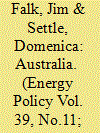

|
|
|
|
|
| Publication |
2011.
|
| Summary/Abstract |
This paper considers energy policy in Australia in the context of its considerable energy resources, climate change and a recent change in government. It examines the possible paths that future energy use and policy in Australia could take, including published projections based largely on a "business as usual" approach and projections based on a dramatic shift towards more efficient use of energy and renewable energy technologies. It also considers the various factors affecting future policy direction, including energy security, the advocacy in Australia for establishing nuclear electricity generation and other parts of the nuclear fuel-cycle, responses to climate change, and carbon sequestration. It concludes that while the Australian Government is currently reluctant to move away from a dependence on coal, and unlikely to adopt nuclear energy generation, a low-emissions future without waiting for the deployment of carbon capture and storage and without resorting to nuclear power is within reach. However, in the face of strong pressure from interest groups associated with energy intensive industry, making the necessary innovations will require further growth of community concern about climate change, and the development of greater understanding of the feasibility of employing low carbon-emissions options.
|
|
|
|
|
|
|
|
|
|
|
|
|
|
|
|
| 3 |
ID:
124719


|
|
|
|
|
| Publication |
2013.
|
| Summary/Abstract |
The combination of bioenergy production and carbon capture and storage technologies (BECCS) provides an opportunity to create negative emissions of CO2 in biofuel production. However, high capture costs reduce profitability. This paper investigates carbon price uncertainty and technological uncertainty through a real option approach. We compare the cases of early and delayed CCS deployments. An early technological progress may arise from aggressive R&D and pilot project programs, but the expected cost reduction remains uncertain. We show that this approach results in lower emissions and more rapid investment returns although these returns will not fully materialise until after 2030. In a second set of simulations, we apply an incentive that prioritises sequestered emissions rather than avoided emissions. In other words, this economic instrument does not account for CO2 emissions from the CCS implementation itself, but rewards all the sequestered emissions. In contrast with technological innovations, this subsidy is certain for the investor. The resulting investment level is higher, and the project may become profitable before 2030. Negative emission in bioethanol production does not seem to be a short-term solution in our framework, whatever the carbon price drift.
|
|
|
|
|
|
|
|
|
|
|
|
|
|
|
|
| 4 |
ID:
099265
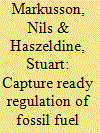

|
|
|
|
|
| Publication |
2010.
|
| Summary/Abstract |
Climate change legislation requires emissions reductions, but the market shows interest in investing in new fossil fuelled power plants. The question is whether capture ready policy can reconcile these interests. The term 'capture ready' has been used a few years by the UK Government when granting licences for fossil fuelled power plants, but only recently has the meaning of the term been defined. The policy has been promoted as a step towards CCS and as an insurance against carbon lock-in. This paper draws on literature on technology lock-in and on regulation of technology undergoing development. Further, versions of the capture readiness concept proposed to date are compared. Capture readiness requirements beyond the minimum criterion of space on the site for capture operations are explored. This includes integration of capture and power plant, downstream operations, overall system integration and regulation of future retrofitting. Capture readiness comes with serious uncertainties and is no guarantee that new-built fossil plants will be abatable or abated in the future. As a regulatory strategy, it has been over-promised in the UK.
|
|
|
|
|
|
|
|
|
|
|
|
|
|
|
|
| 5 |
ID:
104878


|
|
|
|
|
| Publication |
2011.
|
| Summary/Abstract |
Latest estimates suggest that widespread deployment of carbon capture and storage (CCS) could account for up to one-fifth of the needed global reduction in CO2 emissions by 2050. Governments are attempting to stimulate investments in CCS technology both directly through subsidizing demonstration projects, and indirectly through developing price incentives in carbon markets. Yet, corporate decision-makers are finding CCS investments challenging. Common explanations for delay in corporate CCS investments include operational concerns such as the high cost of capture technologies, technological uncertainties in integrated CCS systems and underdeveloped regulatory and liability regimes. In this paper, we place corporate CCS adoption decisions within a technology strategy perspective. We diagnose four underlying characteristics of the strategic CCS technology adoption decision that present unusual challenges for decision-makers: such investments are precautionary, sustaining, cumulative and situated. Understanding CCS as a corporate technology strategy challenge can help us move beyond the usual list of operational barriers to CCS and make public policy recommendations to help overcome them.
|
|
|
|
|
|
|
|
|
|
|
|
|
|
|
|
| 6 |
ID:
097249


|
|
|
|
|
| Publication |
2010.
|
| Summary/Abstract |
At present carbon capture and storage (CCS) is very expensive and its performance is highly uncertain at the scale of commercial power plants. Such challenges to deployment, though, are not new to students of technological change. Several successful technologies, including energy technologies, have faced similar challenges as CCS faces now. To draw lessons for the CCS industry from the history of other energy technologies that, as with CCS today, were risky and expensive early in their commercial development, we have analyzed the development of the US nuclear-power industry, the US SO2-scrubber industry, and the global liquefied natural gas (LNG) industry. Through analyzing the development of the analogous industries we arrive at three principal observations. First, government played a decisive role in the development of all of these analogous technologies. Second, diffusion of these technologies beyond the early demonstration and niche projects hinged on the credibility of incentives for industry to invest in commercial-scale projects. Third, the conventional wisdom that experience with technologies inevitably reduces costs does not necessarily hold. Risky and capital-intensive technologies may be particularly vulnerable to diffusion without accompanying reductions in cost.
|
|
|
|
|
|
|
|
|
|
|
|
|
|
|
|
| 7 |
ID:
177450
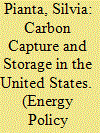

|
|
|
|
|
| Summary/Abstract |
Although Carbon Capture and Storage (CCS) technologies can potentially play an important role in climate change mitigation efforts, commercial CCS projects are still rare. Knowledge about the technical challenges of these technologies is rapidly advancing, but the challenges related to their public acceptance are still underinvestigated. Here we try to close this research gap by investigating public perceptions of CCS and public attitudes towards policies to scale up these technologies in the United States, where most existing industrial-scale CCS projects are operating. Based on a demographically representative sample of US residents, we find that awareness of CCS is very low. Using a conjoint experiment, we show that policies that outlaw the construction of new coal- and gas-fired power plants without CCS find higher public support than CCS subsidies and increases in taxes on unabated fossil fuel power generation. Public support decreases with rising costs of CCS deployment and decreasing minimal distance requirements of CCS plants from residential areas. Our results provide insights into the political feasibility of a large-scale deployment of CCS and show that specific policy design choices play an important role in influencing public support for policies to scale up these technologies.
|
|
|
|
|
|
|
|
|
|
|
|
|
|
|
|
| 8 |
ID:
115692


|
|
|
|
|
| Publication |
2012.
|
| Summary/Abstract |
Carbon Capture and Storage (CCS) is an emerging technology to mitigate greenhouse gas emissions from fossil fuel-fired power plants. In the wake of a rapidly changing German energy system, CCS can play an important role. By means of an online survey among 130 university students in Dresden, this paper investigates the level and influencing factors of social acceptance of CCS. Furthermore, the individual willingness to pay for CCS and renewable power delivery is measured and compared through a choice model. The survey results reveal that the attitude towards CCS is neutral. Moreover, it is shown that acceptance of CCS is an important factor for the willingness to pay. The level of willingness to pay for CCS technology is much lower than for renewable energy.
|
|
|
|
|
|
|
|
|
|
|
|
|
|
|
|
| 9 |
ID:
166307
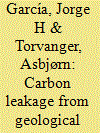

|
|
|
|
|
| Summary/Abstract |
A number of studies show that large-scale deployment of Carbon Capture and Storage (CCS) is necessary to limit the increase in global average temperature to less than 2 °C by 2100. However, some experts and citizens worry about the integrity of carbon dioxide storage sites due to the possibility of future leakage. We introduce a two-period model where two emission mitigation technologies are available to society in the first period: CCS, with a risk of carbon dioxide leakage in the second period, and a riskless mitigation alternative, such as renewable energy. We first solve the model assuming that society does not know what the future rate of leakage will be. We then solve the model assuming that society will eventually learn the actual leakage rate. We find that, in a trading market in period one, reductions of CO2 emissions through CCS should generate a less than proportional amount of CO2 allowances. Estimates from simulations, using a coarse range of parameters, indicate that the discount factor of CCS allowances lies in the range (0.72, 1). Site-specific data is required to determine site-specific risks of leakage and discount factors.
|
|
|
|
|
|
|
|
|
|
|
|
|
|
|
|
| 10 |
ID:
136242
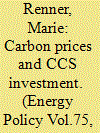

|
|
|
|
|
| Summary/Abstract |
Carbon Capture and Storage is considered as a key option for climate change mitigation; policy makers and investors need to know when CCS becomes economically attractive. Integrating CCS in a power plant adds significant costs which can be offset by a sufficient CO2 price. However, most markets have failed: currently, the weak carbon price threatens CCS deployment in the European Union (EU). In China, a carbon regulation is appearing and CCS encounters a rising interest. This study investigates two questions: how much is the extra-cost of a CCS plant in the EU in comparison with China? Second, what is the CO2 price beyond which CCS plants become more profitable than reference plants in the EU and in China? To address these issues, I conducted a literature review on public studies about CCS costs. To objectively assess the profitability of CCS plants, I constructed a net present value model to calculate the Levelised Cost of Electricity and the breakeven CO2 price. CCS plants become the most profitable plant type beyond 115 €/tCO2 in the EU vs. 45 €/tCO2 in China (offshore transport and storage costs). I advise on the optimal plant type choice depending on the CO2 price in both countries.
|
|
|
|
|
|
|
|
|
|
|
|
|
|
|
|
| 11 |
ID:
149929


|
|
|
|
|
| Summary/Abstract |
One of the main ways that continued use of coal is justified, and compensated for, is through fantasies of technology. This paper explores the politics of 'Carbon Capture and Storage' (CCS) technologies in Australia. These technologies involve capturing CO2 emissions, usually to store them 'safely' underground in a process called 'geo-sequestration'. In Australia the idea of 'clean coal' has been heavily promoted, and is a major part of CO2 emissions reduction plans, despite the technological difficulties, the lack of large scale working prototypes, the lack of coal company investment in such research, and the current difficulties in detecting leaks. This paper investigates the ways that the politics of 'clean coal' have functioned as psycho-social defence mechanisms, to prolong coal usage, assuage political discomfort and anxiety, and increase the systemic disturbance produced by coal power.
|
|
|
|
|
|
|
|
|
|
|
|
|
|
|
|
| 12 |
ID:
124631


|
|
|
|
|
| Publication |
2013.
|
| Summary/Abstract |
This paper argues that an integrated policy architecture consisting of multiple policy phases and economic instruments is needed to support the development of carbon capture and storage (CCS) from its present demonstration phase to full-scale deployment. Building on an analysis of the different types of policy instruments to correct market failures specific to CCS in its various stages of development, we suggest a way to combine these into an integrated policy architecture. This policy architecture adapts to the need of a maturing technology, meets the requirement of policymakers to maintain flexibility to respond to changing circumstances while providing investors with the policy certainty that is needed to encourage private sector investment. This combination of flexibility and predictability is achieved through the use of 'policy gateways' which explicitly define rules and criteria for when and how policy settings will change. Our findings extend to bioenergy-based CCS applications (BECCS), which could potentially achieve negative emissions. We argue that within a framework of correcting the carbon externality, the added environmental benefits of BECCS should be reflected in an extra incentive.
|
|
|
|
|
|
|
|
|
|
|
|
|
|
|
|
| 13 |
ID:
125654


|
|
|
|
|
| Publication |
2013.
|
| Summary/Abstract |
This study shows how the assessment of emissions reductions from CO2 capture is critically dependent on the choice of multi-gas equivalency metric and climate impact time horizon. This has implications for time-sensitive mitigation policies, in particular when considering relative impact of short-lifetime gases. CO2, CH4 and N2O emissions from a coal-fired power plant in Brazil are used to estimate and compare the CO2-equivalent emissions based on standard practice global warming potentials GWP-100 with the less common GWP-50 and variable GWP for impact target years 2050 and 2100. Emission reductions appear lower for the variable metric, when the choice of target year is critical: 73% in 2100 and 60% in 2050. Reductions appear more favorable using a metric with a fixed time horizon, where the choice of time horizon is important: 77% for GWP-100 and 71% for GWP-50. Since CH4 emissions from mining have a larger contribution in the total emission of a plant with capture compared to one without, different perspectives on the impact of CH4 are analyzed. Use of variable GWP implies that CH4 emissions appear 39% greater in 2100 than with use of fixed GWP and 91% greater in 2050.
|
|
|
|
|
|
|
|
|
|
|
|
|
|
|
|
| 14 |
ID:
118832
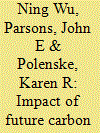

|
|
|
|
|
| Publication |
2013.
|
| Summary/Abstract |
Carbon capture and storage (CCS) in China is currently discussed extensively but few in-depth analyses focusing on economics are observed. In this study, we answer two related questions about the development of CCS and power generation technologies in China: (1) what is the breakeven carbon-dioxide price to justify CCS installation investment for Integrated Gasification Combined Cycle (IGCC) and pulverized coal (PC) power plants, and, (2) what are the risks associated with investment for CCS. To answer these questions, we build a net present value model for IGCC and PC plants with capacity of 600 MW, with assumptions best representing the current technologies in China. Then, we run a sensitivity analysis of capital costs and fuel costs to reveal their impact on the carbon price, and analyze the risk on investment return caused by the carbon price volatility. Our study shows that in China, a breakeven carbon price of $61/tonne is required to justify investment on CCS for PC plants, and $72/tonne for IGCC plants. In this analysis, we also advise investors on the impact of capital and fuel costs on the carbon price and suggest optimal timing for CCS investment.
|
|
|
|
|
|
|
|
|
|
|
|
|
|
|
|
| 15 |
ID:
121346
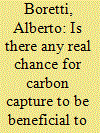

|
|
|
|
|
| Publication |
2013.
|
| Summary/Abstract |
The rapid application of carbon capture and storage (CCS) is a much heralded means to tackle emissions from both existing and future sources that, however, simply may not deliver the expected benefits. Apart from some doubts about the efficacy of the geological storage, the present stall in deploying carbon capture and storage (no fossil-fuel power plants, the greatest source of carbon dioxide emissions, are presently using carbon capture and storage, and publicly supported demonstration programmes are struggling to deliver actual projects) is due to the simple fact that the move to carbon capture and storage would have considerable additional costs for the economy and the environment that would very likely offset all the benefits.
|
|
|
|
|
|
|
|
|
|
|
|
|
|
|
|
| 16 |
ID:
097273


|
|
|
|
|
| Publication |
2010.
|
| Summary/Abstract |
The paper presents a view into the long term future of fossil-fuelled power generation in the European Union, based on a number of alternative scenarios for the development of the coal, natural gas and CO2 markets, and the penetration of renewable and nuclear technologies. The new fossil fuelled capacity needed and the likely technology mix are estimated using a cost optimisation model based on the screening curve method, taking into consideration the rate of retirement of the current power plant fleet, the capacity already planned or under construction and the role of carbon capture and storage technologies. This analysis shows that measures to increase both non-fossil-fuel-based power generation and the price of CO2 are necessary to drive the composition of the European power generation capacity so that the European policy goal of reducing greenhouse gas emissions is achieved. Meeting this goal will however require a high capital investment for the creation of an optimal fossil fuel power plant technology mix.
|
|
|
|
|
|
|
|
|
|
|
|
|
|
|
|
| 17 |
ID:
099250


|
|
|
|
|
| Publication |
2010.
|
| Summary/Abstract |
This paper presents a mathematical model for designing a carbon dioxide (CO2) value chain. Storage of CO2 in geological formations is recognized as an important alternative for carbon abatement. When CO2 is deposited in oil reservoirs it can sometimes be used to achieve additional oil production, enhanced oil recovery (EOR). The model determines an optimal CO2 value chain from a fixed set of CO2 emission points and a set of potential injection sites. It designs a transport network and chooses the best suited oil fields with EOR potential or other geological formations for storage. A net present value criterion is used. The model is illustrated by an example of a Norwegian case with 14 oil fields, two aquifers and five CO2 sources. A sensitivity analysis is performed on the most important parameters.
|
|
|
|
|
|
|
|
|
|
|
|
|
|
|
|
| 18 |
ID:
126550


|
|
|
|
|
| Publication |
2013.
|
| Summary/Abstract |
The paper examined the case study of the Saudi electricity sector and provided projections for energy use and respective carbon dioxide (CO2) emissions for the period 2010-2025 with and without cleaner energy technologies. Based on two sets of 20 life cycle assessment studies for carbon capture and storage and solar photovoltaic technologies, CO2 emission reduction rates were used for projecting future CO2 emissions. Results showed enormous savings in CO2 emissions, for the most likely case, year 2025 reported savings that range from 136 up to 235 MtCO2. Including low growth and high growth cases, these savings could range from 115 up to 468 MtCO2 presenting such an unrivalled opportunity for Saudi Arabia. These projections were developed as a way of translating the inherent advantages that cleaner energy technologies could provide for CO2 emissions savings. It is hoped that the results of this paper would inform energy policymaking in Saudi Arabia.
|
|
|
|
|
|
|
|
|
|
|
|
|
|
|
|
| 19 |
ID:
132759
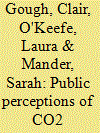

|
|
|
|
|
| Publication |
2014.
|
| Summary/Abstract |
This paper explores the response by members of the lay public to the prospect of an onshore CO2 pipeline through their locality as part of a proposed CCS development and presents results from deliberative Focus Groups held along a proposed pipeline route. Although there is a reasonable level of general knowledge about CO2 across the lay public, understanding of its specific properties is more limited. The main concerns expressed around pipelines focused on five areas: (i) safe operation of the pipeline; (ii) the risks to people, livestock and vegetation arising from the leakage of CO2 from the pipeline; (iii) the innovative and 'first of its kind× nature of the pipeline and the consequent lack of operational CO2 pipelines in the UK to demonstrate the technology; (iv) impacts on coastal erosion at the landfall site; and (v) the potential disruption to local communities during pipeline construction. Participants expressed scepticism over the motivations of CO2 pipeline developers. Trust that the developer will minimise risk during the route selection and subsequent construction, operation and maintenance of the pipeline is key; building trust within the local community requires early engagement processes, tailored to deliver a variety of engagement and information approaches.
|
|
|
|
|
|
|
|
|
|
|
|
|
|
|
|
| 20 |
ID:
104961


|
|
|
|
|
| Publication |
2011.
|
| Summary/Abstract |
Coal-to-liquids (CTL) processes that generate synthetic liquid fuels from coal are of increasing interest in light of the substantial rise in world oil prices in recent years. A major concern, however, is the large emissions of CO2 from the process, which would add to the burden of atmospheric greenhouse gases. To assess the options, impacts and costs of controlling CO2 emissions from a CTL plant, a comprehensive techno-economic assessment model of CTL plants has been developed, capable of incorporating technology options for carbon capture and storage (CCS). The model was used to study the performance and cost of a liquids-only plant as well as a co-production plant, which produces both liquids and electricity. The effect of uncertainty and variability of key parameters on the cost of liquids production was quantified, as were the effects of alternative carbon constraints such as choice of CCS technology and the effective price (or tax) on CO2 emissions imposed by a climate regulatory policy. The efficiency and CO2 emissions from a co-production plant also were compared to the separate production of liquid fuels and electricity. The results for a 50,000 barrels/day case study plant are presented.
|
|
|
|
|
|
|
|
|
|
|
|
|
|
|
|
|
|
|
|
|